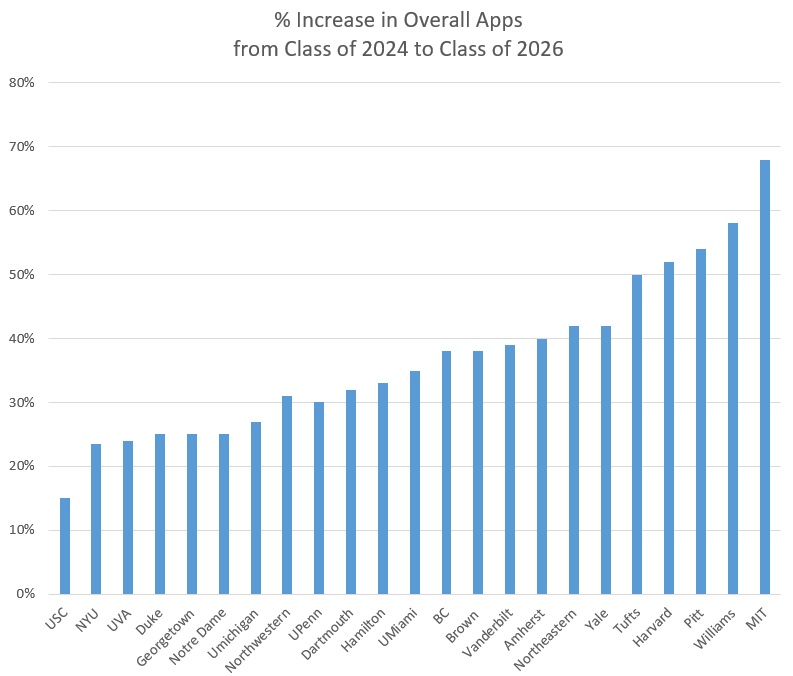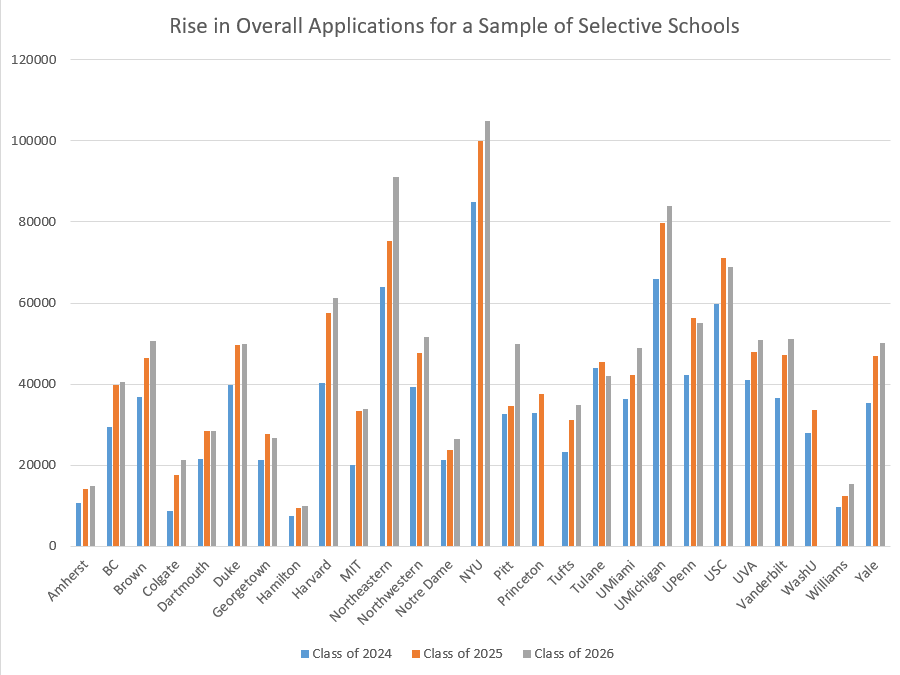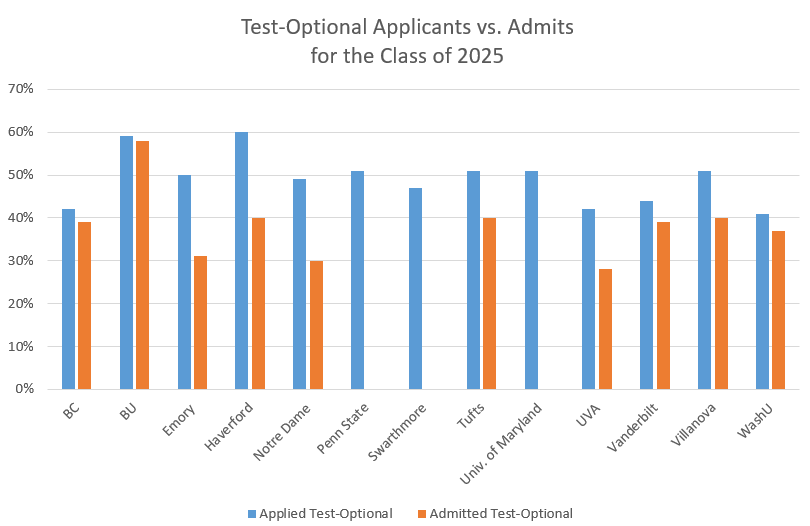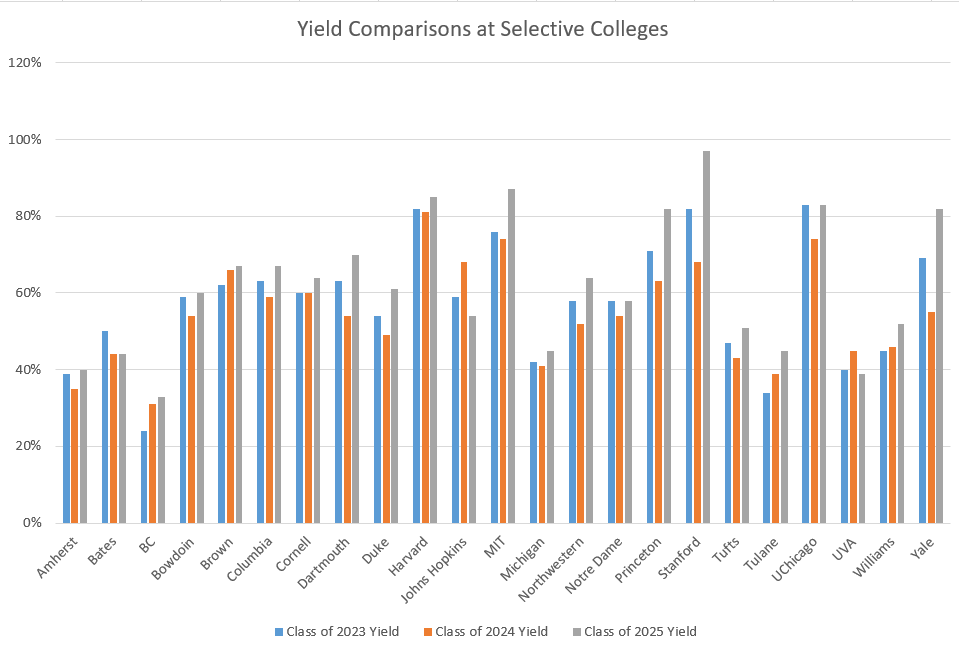 The impacts of the pandemic are wide-reaching, but who could have guessed that it would result in an exceptional increase in college applications for selective schools over the past two years? Last year, the inability to take standardized tests in-person—and colleges adopting test-optional policies as a result—gave many students unrealistic hopes of being accepted to their dream school. This year, most colleges extended their test-optional policies, and applicants continued to apply to many more highly selective schools. Many schools also credit their virtual outreach programs for increasing applications from a more diverse applicant pool. For an in-depth analysis and interpretation of early admissions trends for the Class of 2026, click here.
The impacts of the pandemic are wide-reaching, but who could have guessed that it would result in an exceptional increase in college applications for selective schools over the past two years? Last year, the inability to take standardized tests in-person—and colleges adopting test-optional policies as a result—gave many students unrealistic hopes of being accepted to their dream school. This year, most colleges extended their test-optional policies, and applicants continued to apply to many more highly selective schools. Many schools also credit their virtual outreach programs for increasing applications from a more diverse applicant pool. For an in-depth analysis and interpretation of early admissions trends for the Class of 2026, click here.
Last year, as colleges struggled to predict yield and accommodate deferrals from the Class of 2024, many schools over-enrolled the Class of 2025. Over-enrollment and uncertainty may have led to the perfect storm this year! Not only did highly selective schools continue to receive a high volume of applications, but now it seems that many selective state universities with non-restrictive early action programs also saw a tremendous increase in applications. This trend is leading to confusion and worry for top students who have been deferred or denied at institutions which were previously considered “safe” or even “target” schools.
This blog post will explore the sharp rise in applications to America’s highly selective public and private schools and what applicants can continue to do to improve their chances.
Overall Applications at Many Selective Schools Continue to Rise
More and more applications are pouring in at American’s top schools. Compared to two years ago, Colgate has seen an unprecedented 146% jump in applications. This year, MIT received 33,796 apps; pre-pandemic they typically received an average of 20,000. Applications to MIT have increased by 68% over the past two years. Boston University, Brown, the University of California system, Duke, Florida State University, Harvard, Middlebury, and Yale (just to name a few) had their largest applicant pools in school history for the Class of 2026.
Last year, Jenny Rickard, President & CEO of the Common App, reported that there was a 9% increase in the application per applicant ratio. For the Class of 2026, as of November 16, 2021, the Common App reported a 13% increase in the number of college applicants and a 22% jump in the total applications submitted.
Over-enrollment for the Class of 2025
Many schools over-enrolled the Class of 2025 and, as a result, have admitted fewer applicants to the Class of 2026. USC plans to offer Fall 2022 admission to about 8,200 students—7% less than last year—due to over-enrollment the past two years. J.T. Duck, Tufts Dean of Admissions for the School of Arts and Sciences and the School of Engineering said, “Given last year’s strong positive response to our offers of admission, we have made slightly fewer offers this year and hope to be able to admit some outstanding students from our wait list in May.”
Selective private and public universities are dealing with over-enrollment that is breaking school records. This fall, at the University of Michigan, the total student body was more than 50,000 for the first time in school history and the Class of 2025 enrollment increased by more than 400 students. The University of Wisconsin-Madison enrolled the largest class in school history, 8,465 incoming freshmen, up 16% over the previous year. At the University of Pittsburgh, the Class of 2025 broke school enrollment records and the Class of 2024 was over-enrolled as well. Kellie Kane, Pitt’s Director of Admissions, stated:
“The University of Pittsburgh welcomed a larger-than-expected fall 2021 first-year class of 4,927 students to the Pittsburgh campus — a record number as a result of higher-than-projected yield of students from Pennsylvania more than likely due to the uncertainty of the pandemic.”
More Diverse Applicants
Many schools continue to welcome and encourage diverse applicants through admissions outreach programs. Overall, UVA had a 22% increase in first-generation applications and 19% increase in international applications compared to last year. Notre Dame “received a 21% increase in first-generation student applications, a 16% increase in U.S. student of color applications and a 32% increase in international student applications.” Yale also points to a large increase in international applicants. Tufts mentions:
“Applications from international students, first-generation-to-college students, students of color, and students from beyond the U.S. Northeast are outpacing the growth of the overall pool… Applications from international students increased 29%, while U.S. applicants increased 7%, with Black, multiracial, and Latinx populations reflecting the largest growth; students of color now account for 56% of all US applicants.”
Last fall, Brown announced that over the next four years they plan to extend need-blind admissions policy to international students, which could continue to greatly increase international applications. In January, Dartmouth expanded its need-blind admissions program to include all applicants, regardless of citizenship.
Many Applications Were Submitted Without Test Scores
Continuing to offer a test-optional alternative led to a significant increase in applications for many colleges as students who either had no test scores or scores that were not competitive now felt they had a shot at acceptance. According to Forbes, the Common App reported that only 49% of applicants had submitted test scores with their applications this year, compared to 77% two years ago. At many schools, almost half of applicants did not submit test scores.
Many schools have not released their test-optional applicant data for the Class of 2026. For perspective, the chart below compares information for the Class of 2025 admissions cycle, showing that the percent of admitted students who applied test-optional is lower than the overall percent who applied test-optional.
For the Class of 2026, about half of the applicants to Tufts did not submit test scores, and 40% of admitted students were test-optional. Barnard released that 58% of its applicants were test-optional and 47% of admitted students did not submit scores. The discrepancy is particularly marked at Emory, where last year 50% of the applicants applied test-optional, while only 30% of the admitted pool had not submitted scores.
This year, Georgetown was one of the few selective schools that required the SAT or ACT for all applicants, unless the student experienced pandemic-related circumstances, such as a last minute testing administration cancellation. MIT announced for the 2022-23 admissions cycle, they will once again require ACT and SAT scores. It is to be seen if this reduces their number of applications closer to pre-pandemic numbers.
Interestingly, most colleges that became test-optional on a trial basis in response to Covid-19 have now committed to continuing their test-optional policies for the next one to two years. The University of California system will no longer use the ACT and SAT, and last year UC-Berkeley adopted a “test-blind” policy, which means no test scores were considered for any applicant.
Takeaways and Next Steps
The overall increase in applications continues to cause unprecedented selectivity at already competitive schools. The early admissions process also saw a spike in applications to selective schools, resulting in a large number of deferrals.
Yield, the percentage of students who accept offers of admission, increased at many selective schools for the Class of 2025. For example, Tulane’s yield rose to 45% last year as the school now fills 55-58% of the incoming class through its Early Decision program. In 2016, Tulane’s yield was only 26%. As colleges struggle to predict responses of admitted students, their use of their waitlist will depend on a variety of factors, including yield, deferrals, and institutional priorities. It is notable that many schools saw a dip in yield for the Class of 2024, most likely caused by uncertainty as a result of the pandemic.
The main takeaway may be: Be patient as the process unfolds.
In the meantime, here are a few ways you can strengthen your regular admissions chances:
- Continue to engage in your high school courses and earn high grades.
- If you are waitlisted, send letters to your top colleges expressing your continued interest. If the college is your clear first choice, say that you would attend if accepted. Mention any updates, such as awards, special academic achievements, or extracurricular projects that have occurred since you submitted your original application.
- Review each college’s admissions website to learn specifically what follow-up information they would like to receive, including additional recommendations and test scores. Nearly all colleges will accept informational updates that help them assess your candidacy from a fresh perspective.
It is important to continue to check your Student Applicant Portal for each college. For example, UVA states:
You do not need to send us letters of continued interest (LOCIs). All deferred students and those offered a spot on the waiting list will have a form in their portal to fill out instead of a LOCI. That is the only demonstration of interest we need. Please follow our directions on this! It streamlines the process for you and for us!
As you await your final college decisions, remember to trust in the process, and remind yourself that you have done all you can to maximize your chances of success. Have faith that you will have an exciting range of college options for this fall.
At Collegiate Gateway, we know how difficult this period of waiting for college decisions can be. We are happy to guide you in developing a “best-fit” college list that will help you reach your potential and position you for success! Sign up for a free consultation and see our events schedule for virtual presentations geared toward high school students.




